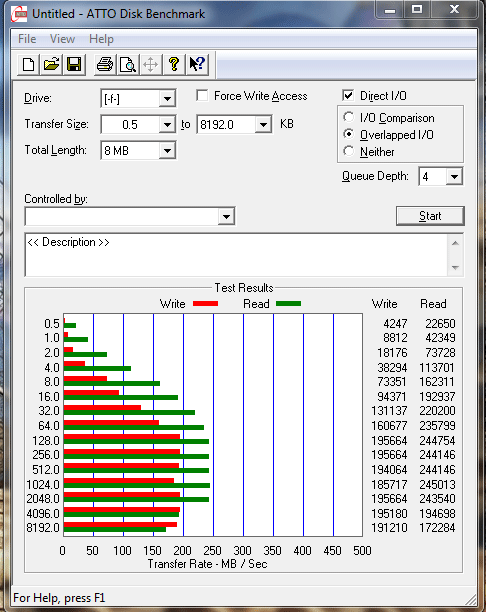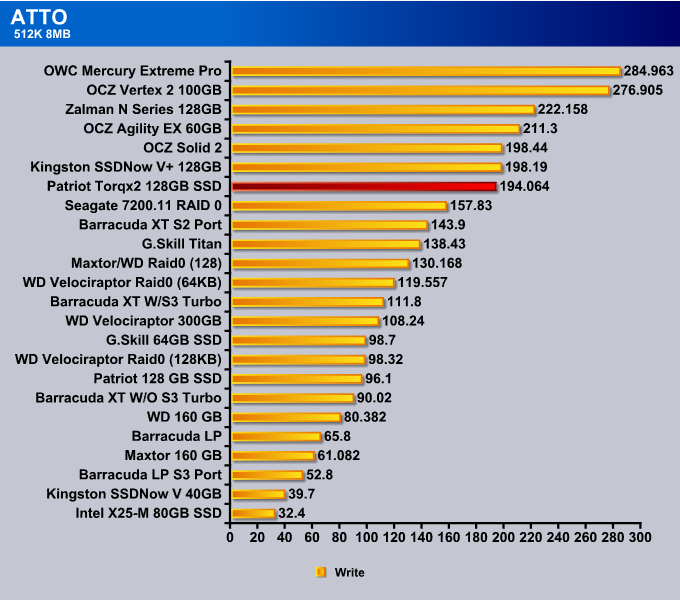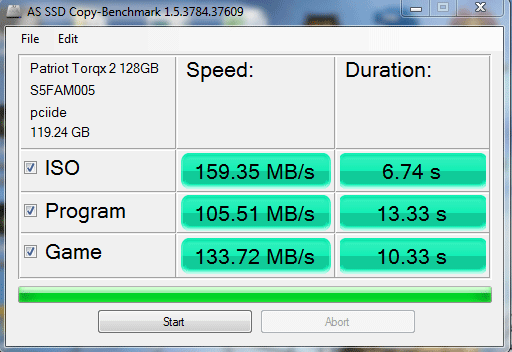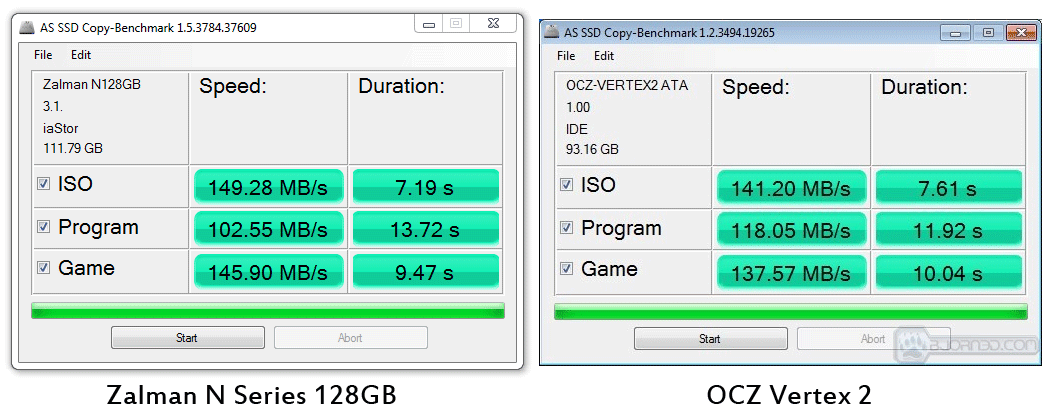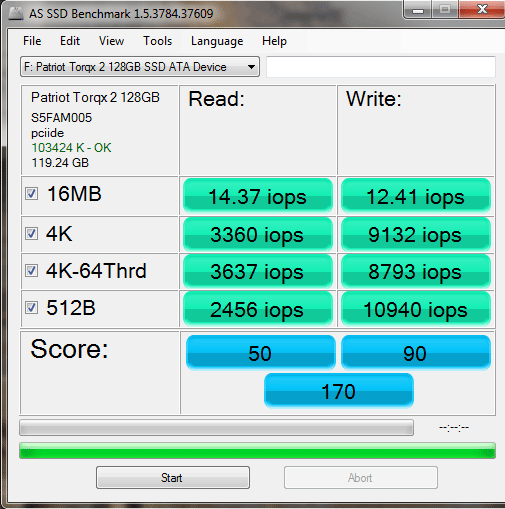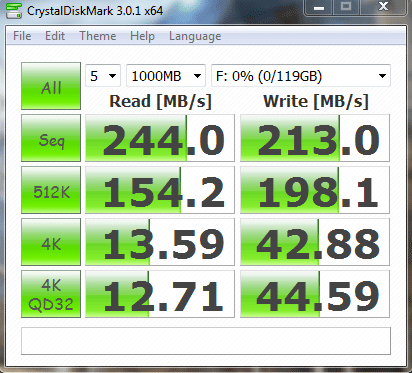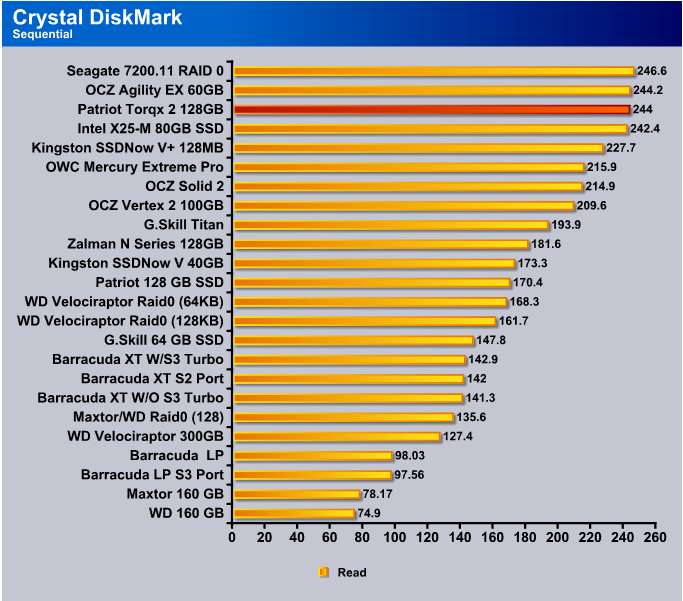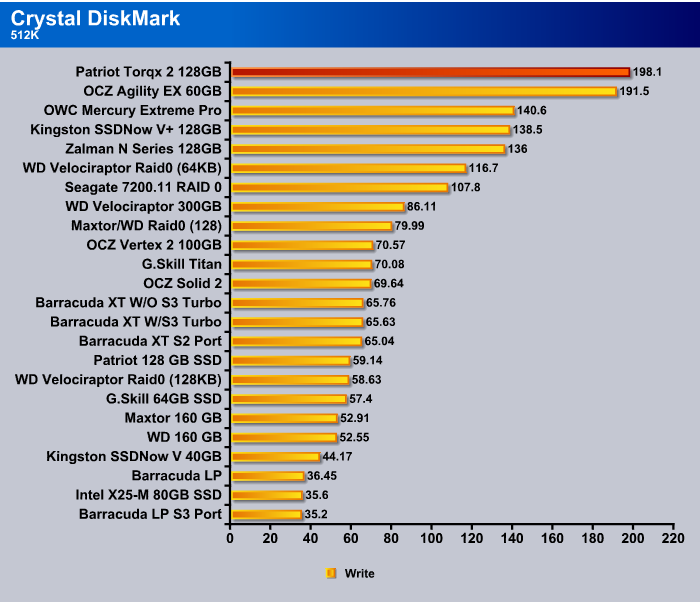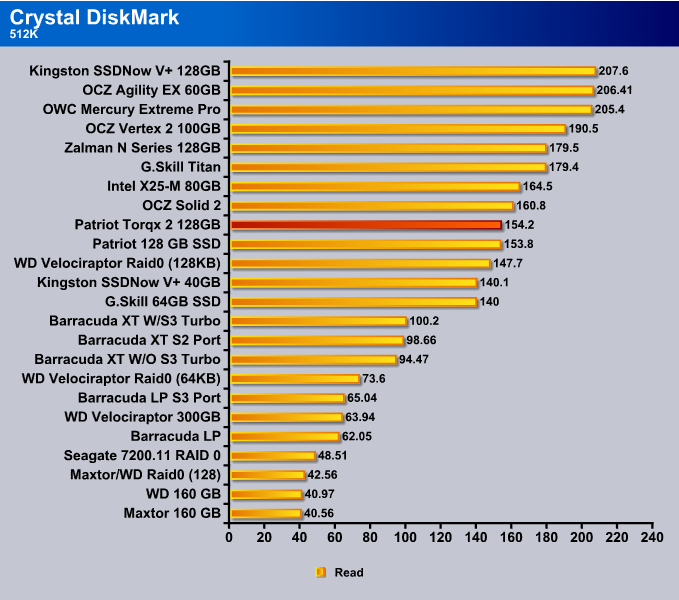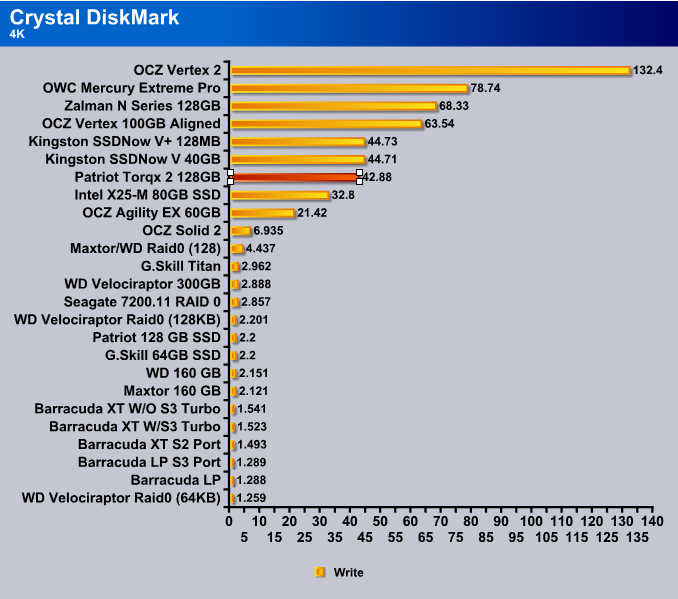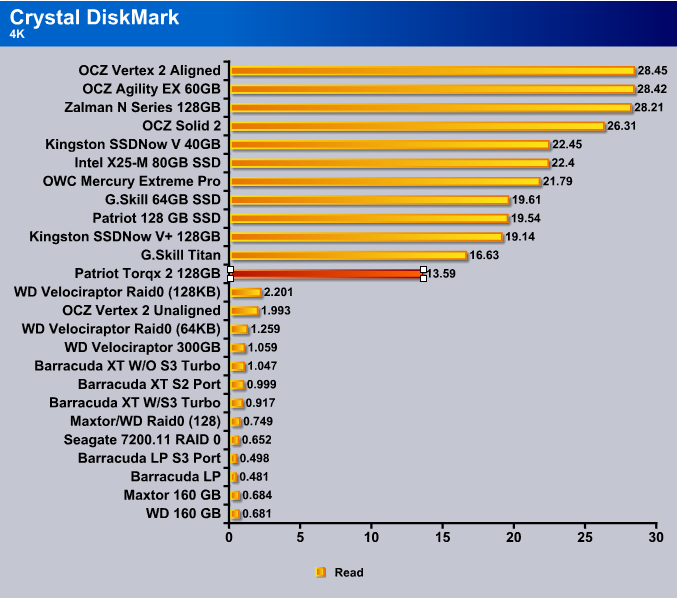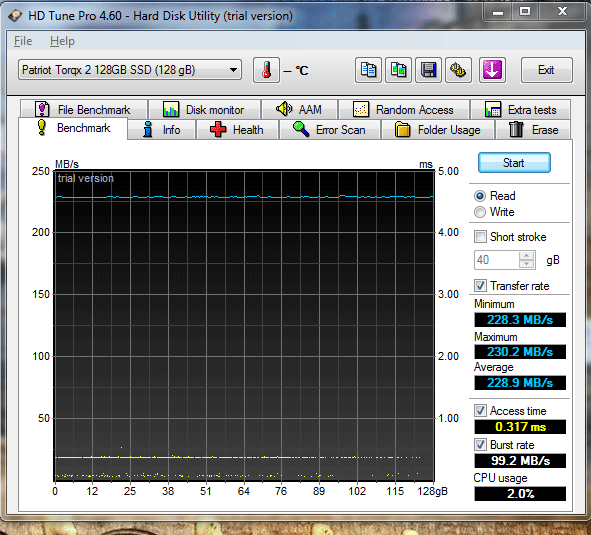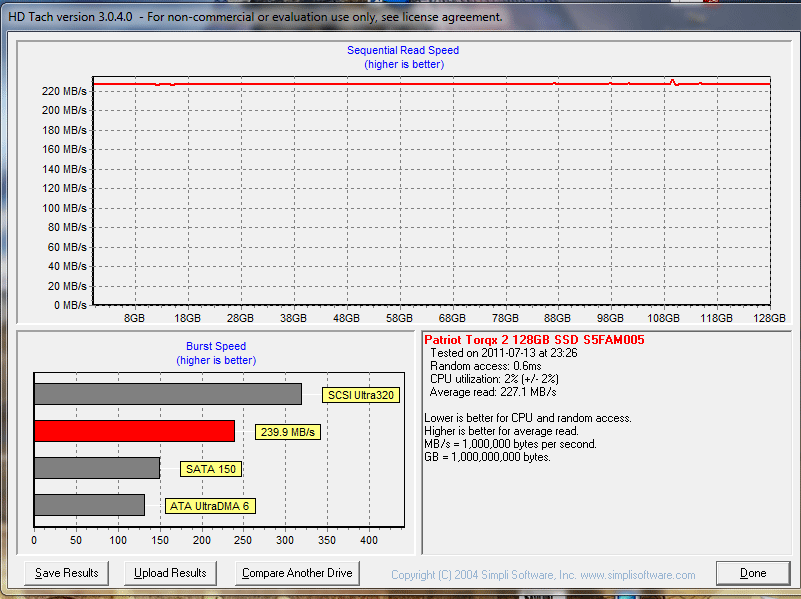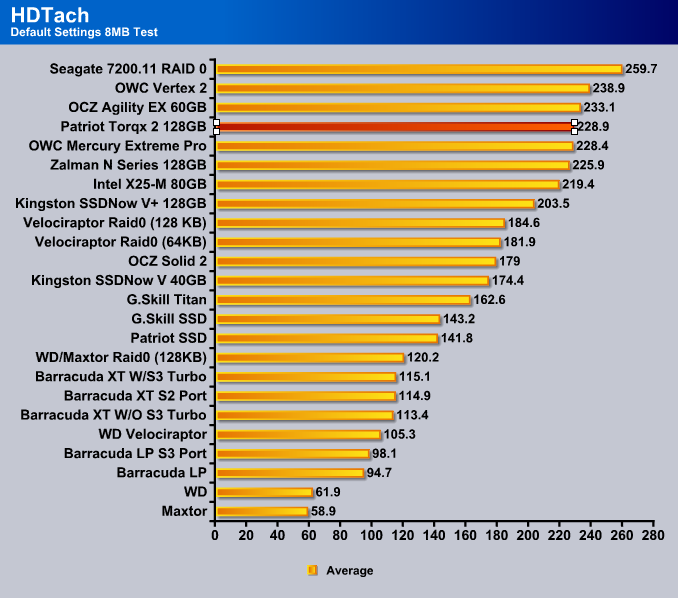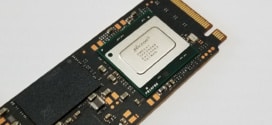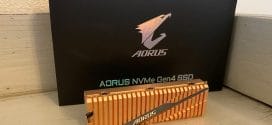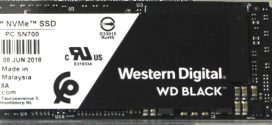SATA III SSD’s are taking the market by storm. Is a SATA II SSD still worth the investment? Read on as we test the daylights out of this SATA II SSD, and see if it’s still worth its price!
Introduction
Those who have kept up with the progression of solid state drives within the next couple years might notice just how much did the quality and performance of the solid state drive change. Some of the most popular SSD companies including Patriot have come a long way in optimizing their SSDs to not only improve overall performance and quality, but also to make their products more accessible to the general public. Since the release of the first generation TorqX SSDs with the Indilinx controller, the series has undergone a drastic change in improvement, resulting in the release of TorqX 2 with the brand new Phison PS3105-S5 controller, which will be covered in this review.
Retailing at $199 USD, the Patriot Torqx2 SATA I/II 128GB drive is considered one of the high end performance drives. However, Torqx2 is not limited to 128 GB, and also comes in storage variations of 32 GB, 64 GB and 256 GB, with price tags of $74.99, $114.99, and $489.99 respectively. The expected performance for this SSD is listed as 270 MB/s read and 230 MB/s write.
Features & SPECIfications
Sequential Read: up to 270MB/s*
Sequential Write: up to 230MB/s*
Interface: SATA I/II
TRIM Support (O/S dependent)
RAID Support: Yes
128MB DRAM Cache
Power Consumption:
DC 5V
Standby 0.5W
Operating 5.3W
MTBF: > 1,500,000 Hours
Data Retention: >5 years at 25° C
Data Reliability: Built in BCH 9, 24-bit ECC
Operating Temperature: 0°C~70°C
Storage Temperature: 40°C~85°C
Operating Shock: 1,500G (@ 0.5msec half sine wave)
Vibration Resistance: 20G/80~2000Hz w/ 3 axis
Humidity: 0°C to 55°C / 95% RH, 10 cycles
O/S Support: Win XP / Vista / 7
*Based on internal ATTO Disk Benchmark testing
** Capacities stated are unformatted. The total formatted capacity for the drive will differ, depending on the operating system and file system used.
An overview of SSD’s
“SSD”, as most already know, stands for Solid State Drive, which means no moving parts to generate noise or wear out. Currently, they use NAND Flash technology, of which there are two types: SLC (Singe Level Cell) and MLC (Multi-Level Cell). Both SLC and MLC take up the same amount of space and the difference between the two is how the data is stored. First, let’s take a look at how a NAND Flash Cell is set up.

Each individual cell is actually a transistor with the form pictured above. Each cell can hold one bit of data. The user writes to the cell by electron tunneling, applying the correct amount of voltage to the gate, and electrons tunnel through the oxide into the floating gate. Applying the voltage to the channel instead of the gate reverses the bias, and electrons go the other way. NAND Flash has two states, 1 and 0. When the user turns off the power, the data remains, so it’s great for even long-term storage. The data should remain in pristine condition without power for 10 years if 10% of the drive’s normal lifespan has already been used. MLC drives are rated for 10,000 cycles. If the user has read and written data (Programmed and Erased) to the drive 10,000 times, which is the expected life cycle of each cell, then the data should last a year. The life cycle of SLC Solid State Drives is 100,000 cycles. With SLC, one bit of data is written to one cell and with MLC, two bits of data are written to each cell. While users get more storage with MLC for the same space and the same number of cells, it’s harder on the cells to store and retrieve information information that way. “Why didn’t they just make SLC drives?” SLC drives are twice as expensive to make because they require one cell for every “bit” of data. In effect, MLC drives store twice the information at half the cost, which is why they are less expensive than SLC drives.
SLC vs MLC
What are the main differences between the SLC and MLC drives? The two main differences between SLC and MLC are lifespan, and data storage method. We need another graphic here.

In an SLC drive, there are only states 0 and 1, off and on (two voltages). In an MLC there are states 11, 10, 01, 00 (4 voltages). It takes longer to access the MLC cell because it has more data in it and the drive controller has to be more careful with it not to write the wrong data. It’s the same minimum and maximum voltages as the SLC cell uses, but the MLC has more graduations between the minimum and maximum voltages. This affects performance somewhat.
| SLC NAND flash | MLC NAND flash | |
| Random Read | 25 µs | 50 µs |
| Erase | 2ms per block | 2ms per block |
| Programming | 250 µs | 900 µs |
When the cell is being erased they have the same performance. It takes twice as long to read an MLC as it does to read an SLC, which makes sense because it contains twice as much data. Writes (Programming) can take almost four times as long. So even though they use the same NAND Flash transistor, it takes twice as long to read from the MLC as it does to the SLC, and four times as long to program an MLC as it does an SLC. The SLC lasts 10 times as long as an MLC (100,000 cycles vs 10,000 cycles). That lifespan difference because the MLC stores twice as much data per cell.
Life Span
How do we define the lifespan of a drive? We’ve been talking about cycles. A cycle is comprised of one read and one write to one cell. SLC lasts 100,000 cycles, MLC lasts 10,000 cycles.
How The Cells Are Arranged
A group of cells together comprises a page. A page is the smallest block can be written to, and is 4KB in size. After a page comes a block. A block is comprised of an amount of pages. In an Intel MLC, a block is comprised of 128 pages (4×128 – 512KB). Users can write to a single page within the block. To erase a page, users have to erase the block (512KB) that the page is part of. This saves wear and tear on the drive’s cells. Say we write a 12KB file to the drive, which then needs to be deleted. The 12KB file is saved as 3 pages. When we go to erase it, if the block of 128 pages isn’t full, it just marks the 3 pages as invalid, sort of like a regular hard drive does with a file. On a regular hard drive, unless the drive space the file is in is wiped, the file is really still there. In that case, the drive just knocks off the first letter of the file name and replaces it with a “?” and the operating system stops displaying the file. The same principle applies with an SSD. The file is marked with a “?” and is erased at an efficient time (when the whole block needs to be erased).
Is The SSD Going To Fail On Me Like The Thumb Drive Did?
We suspect most SSD’s are designed with a fail safe system that will inform users well in advance that the drive will fail. The nice part about this is that the SSD knows exactly which cells it can and can’t write to, and it has a cell leveling algorithm that makes sure the cells are used about the same amount, meaning that the drive uses intelligent programs and electronics to ensure no one set of cells is used any more than another. Otherwise, some cells would get heavier use and fail quicker than others. That begs the question, if one cell fails, does the whole drive die? The answer is no. The drive keeps a certain amount of blocks in reserve, not allocated to the advertised drive space and uses them as blocks fail.
Pictures & Impressions
Patriot Torqx2 comes in a nice and colorful packaging made to draw the attention of the consumer. The description on the front cover is right to the point. The cut out in the front cover reveals the actual product, which is nice since the SSD is certainly significantly smaller than any 2.5″ HDD. The back of the package expands more on the features that Patriot Torqx2 has to offer as well as displays warranty and contact information in case the drive goes bad. However, there is no mention of the TRIM command, which would be an outstanding feature to mention, since it allows for a simple maintenance of the drive in order to retain its original performance. The product does come with a 2 year warranty, which a definite bonus considering that estimating longevity of the SSD is rather difficult.
Beneath the cardboard packaging, consumers will find the hard drive nicely protected by a plastic cover. Since SSD’s are not as prone to mechanical damage as HDD’s, the packaging does provide sufficient protection in order to deliver a 100% working drive. The manual inside the packaging is rather brief and is also right down to the point. In the manual the consumer will find the dimensions of this drive, as well as a more detailed set of features and specifications.
The Patriot Torqx2 128 GB SSD is a 2.5″ drive made with light material, making it a valuable contribution to a portable system. The drive is also available in 32GB, 64GB, and 256GB variants with cover dimensions of 100mm (l) x 66mm (w) x 9.3mm (h). This SSD does support both SATA I/II, but note that the bandwidth is not expected to exceed the SATA II limitations (roughly 375 MB/s). This SATA II drive is certainly going to be outperformed by the newer SATA III SSDs. However, with estimated performance of sequential read to write of 230 MB/s to 270 MB/s this drive is still expected on of the faster and higher-end SSDs. Note that the SSD uses a tool-less installation system, and removing the silver sticker voids the drive’s warranty.
Here we’ve removed the cover of the drive (this also voids the warranty), and the design shows a few changes in the TorqX 2 series as compared to its predecessor. Of particular interest is the new Phison chip, which is rumored to deliver performance equal to some of the highest-end SSDs. Unlike Indilinx or SandForce, Phison controllers are not widely seen in SSD and offers a completely different perspective on the performance. Since we have not yet had the opportunity to test the Phison chip, we fully intend to push this drive to its limit and compare it’s Phison controller to the more common ones.
While the Phison controller is intriguing, the other components do not fail our expectations either. The product is made in Taiwan, and all of the chipset components are high quality. For example, the mobile DDR SDRAM chip by Hynix semiconductor is considered on of the top tier controllers for the SSDs. After taking a quick glimpse at this new and intriguing chip, there is only one thing left to do: TEST IT!
Testing & Methodology
To test the Patriot Torqx2 SSD, we installed Windows 7 Professional on it along with all the applications that a standard PC would use. We have also placed Music, Pictures, and Videos on it to simulate the real-life personal use that a user would use the SSD for. Windows 7 has also been fully updated to the latest version along with other software. To get accurate readings however of the true performance of the drive, we have disabled all background applications, besides what Windows 7 Pro already comes with. This way nothing that may affect the outcome of the testing procedure can interfere. We ran all of the tests a total of 3 times and averaged those results. The Average of the three results are presented here. In the case of a pictorial benchmark we ran the bench 3 times and picked the median result. As with most SSDs, testing differences from run to run are minimal and the median result is a good indication of what you can expect from the drive.
We ran our usual battery of tests on the drive, and used it as the primary boot drive during testing. All of the drives tested were used as the primary boot drive during testing. That’s a more realistic test than strapping the drive in and testing it with a bare format or as a non-boot drive, and it represents real life transfer rates, much like you can expect when you install and operate the drive in your own system. Each test was performed 3 times and the average of the 3 test run is reported here.
Almost all tests are measured in MB/s, and in general higher numbers are better than lower, unless otherwise stated in the charts. For latency tests measured in ns, lower numbers are better.
Test Rig
| Test Rig | |
| Case | Silverstone Temjin TJ10 |
| CPU |
Intel Core i7 930 @ 3.8GHz |
| Motherboard |
ASUS Rampage III Extreme ROG – LGA1366 |
| Ram |
OCZ DDR3-12800 1600MHz (8-8-8-24 1.65v) 12GB Triple-Channel Kit |
| CPU Cooler | Thermalright True Black 120 with 2x Zalman ZM-F3 FDB 120mm Fans |
| Storage |
4x Seagate Cheetah 600GB 10K 6Gb/s Hard Drives 2x Western Digital RE3 1TB 7200RPM 3Gb/s Hard Drives 1x Zalman N Series 128GB SSD – SSD0128N1 |
| Optical | ASUS DVD-Burner |
| GPU |
ASUS GeForce GTX 580 Voltage Tweak |
| Case Fans |
2x Zalman ZM-F3 FDB 120mm Fans – Top 1x Zalman Shark’s Fin ZM-SF3 120mm Fan – Back 1x Silverstone 120mm fan – Front 1x Zalman ZM-F3 FDB 120mm Fan – Hard Drive Compartment 1x Zalman ZM-F3 FDB 120mm Fan – Side Ventilation for Video Cards and RAID Card SAS Controller. |
| Additional Cards | LSI 3ware SATA + SAS 9750-8i 6Gb/s RAID Card |
| PSU |
Sapphire PURE 1250W Modular Power Supply |
| Mouse | Logitech G5 |
| Keyboard | Logitech G15 |
Test Suite
The following applications were used to test the performance of the SSDs in our results.
|
Benchmarks |
|
ATTO |
|
HDTach |
|
Crystal DiskMark |
|
HD Tune Pro |
|
AS SSD Benchmark |
ATTO
ATTO was used as the first candidate to test the capabilities of the drive. The most useful feature of this particular benchmark is to test the drives response in variation to the change in size of the drive. Settings used in this test suite were fairly standard testing the transfer size of varying sizes from 0.5 KB to 8192.0 resulting in total amount of 8 MB in length for each individual file size.
ATTO revealed that Patriot Torqx2 SSD has reached it’s peak transfer speed in both read and write with the minimal size of 128 KB per individual file. The peaks for both read and write landed at around 196 MB/s and 244 MB/s. While it is a 30 MB/s decrease from the expected peak performance, the results make sense since SSDs do demonstrate a roughly 10% decline in peak performance once the files are uploaded. The results are fairly consistent up to the size of 4KB. Results of files smaller than 4KB should be disregarded due to the total length size. Since transferring such files would only take 1-2 seconds, the margin of error is far too great for these results to even be considered. (The comparison graphs below will only reflect the consistent data.)
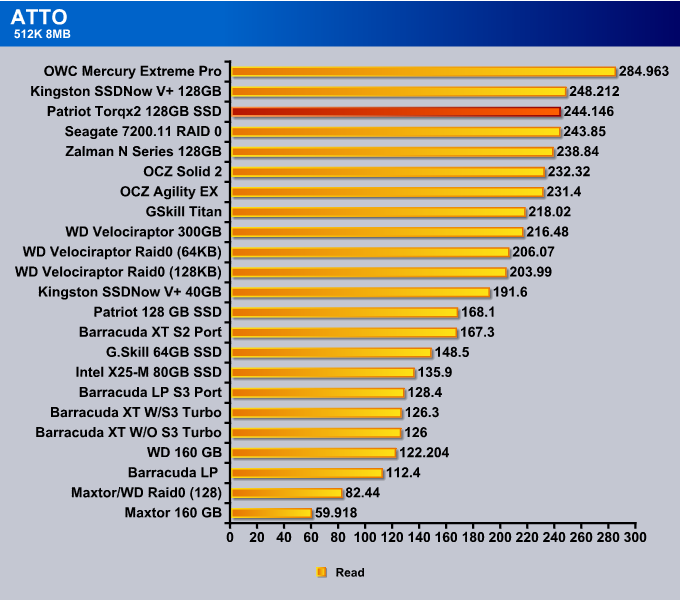
In comparison to other solid state drives, the Patriot TorqX 2 has demonstrated a rather impressive read capability at the 512k file size, landing it above Zalmans N series SSD, and above the Seagate hard drives in RAID 0 configuration. At this point the performance is certainly comparable to other high end SATA II solid state drives.
In terms of write the performance is quite noticeably lower than Zalman N series. However, the performance seems to consistently fall 4 MB/s short of the Kingston SSDNow V+ 128 GB. Overall, in comparison to other high end solid state drives, the TorqX 2 falls behind at 512k transfer size.
AS SSD
AS SSD is an outstanding suite to test SSD capabilities. As the software oriented specifically for SSD, it is meant to push SSDs to their limit demonstrating a more significant difference in performance in comparison to the competition. The tests include a regular sequential transfer, which demonstrates the peak of any SSD as well as the transfer of a significantly smaller 4k-64k files which is extremely difficult for drives with long access. time. Since access time or the lag time that it takes to access each individual file is an important factor it is also listed as a viable measure for comparison.
The results observed in this benchmark seem to be consistent with ATTO, with just a slight decrease in performance. In terms of sequential read, the Patriot TorqX 2 128 GB SSD seems to demonstrate a rather outstanding performance contrasted by a significant drop in read and write ass the file size decreases at the 4k file size. The major reason for this read and write is directly related to access time, which is perhaps one of the most important qualities of the solid state drives. Now let us take a look at how the Patriot TorqX 2 does compared to other solid state drives.
Patriot Torqx 2
While the sequential read of Patriot TorqX 2 is impressive, the 4k-64 thread cache seems to be a problem for this drive, which makes us question how well the drive is able to perform in live settings in comparison with others. Fortunately, AS SSD offers a set of realistic benchmark that will allow us to see how well the drive performs in real-life settings. By comparing the TorqX 2 with high-end SSDs like the Zalman N series and OCZ Vertex, it is clearly obvious that the drive is in every way up for the competition. While there is a slight delay in the load of the program, the ISO performance by far stood out for TorqX 2.
Patriot Torqx 2
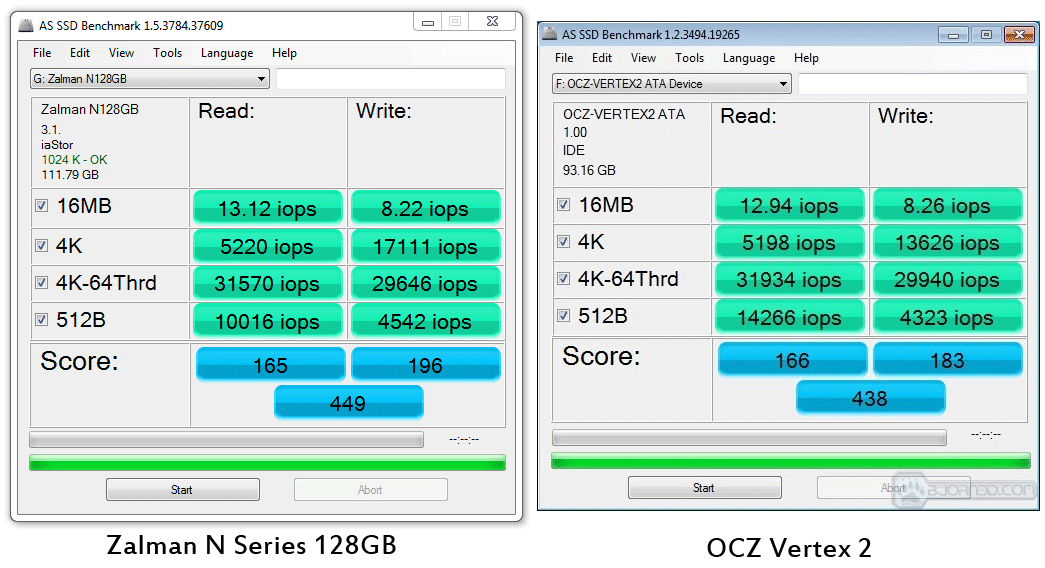
Finally, in order to see just how different the 4k-64 thread performance of high-end SSDs from Zalman and OCZ is in comparison to the Patriot TorqX 2, we decided to run the IOPS test in the AS SSD testing suite. Clearly the difference in access time of smaller files is noticeable when the file size is lowered, but at higher file sizes, the TorqX 2 performance is simply unmatched. Since in real settings the files are mostly over 1 MB, the performance of the TorqX 2 is definitely able to stand up to other high-end SSDs.
CrystalDiskMark
Crystal Disk Mark is a conventional benchmark for both SSDs and HDDs. Like other benchmarks it test the drivers transfer rate in response to various file sizes. The total length we used was 1000 MB/s, in order to test the performance of transfer for larger files. Individual files size yet again vary and go down to as low as 4KB per file.
The results of Crystal Disk Mark are fairly impressive for sequential read. With a read speed of 244 MB/s and write of 213 MB/s this drive has certainly the performance to compete against other SSDs. However, as more data was added the sequential read seems to have increased to 251 MB/s in the following tests.
The Patriot TorqX 2 demonstrates a rather impressive performance in Crystal Disk Mark in sequential read. The drive put out a speed of 213 MB/s for the write, which lands it second on our chart, right below the Seagate HDD’s in RAID 0 configuration. While in ATTO we saw a rather low level of write performance at 512k, this drive is clearly designed to deliver high and constant performance for sequential write.
The sequential read is yet again above all previously tested SSDs and lands right below the RAID 0 configuration. In comparison to the sequential read there is roughly a 30 MB/s difference which seems to become a rather consistent pattern in performance for this product.
CrystalDiskMark results for 512k write performance seems to show a significant improvement over 512k tests in the ATTO benchmark. The write speed of the Patriot Torqx2 appears to reach 154.2 MB/s, making it one of the best performers in CrystalDiskMark’s 512k test.
The read performance for 512k does not fail to disappoint either and retains the minimum 30 MB/s increase in performance in comparison to write. In fact, in this particular instance the difference in performance between read and write seems to be a shocking 44 MB/s. In comparison to other drives Patriot Torqx 2 takes the lead in performance in Crystal Disk Mark.
With file size lowered down to 4k, the performance of the Torqx 2 seems to drop significantly. While demonstrating phenomenal performance in both sequential write and 512k, the drive does yield to other SSDs in the lower file size. However, with a speed of 44.88 MB/s, the drive still seems to perform at the level of Kingston SSDnow V+ 128 GB.
Finally, at 4k read Patriot TorqX 2 demonstrates a significantly lower read than the above observed write, landing at the lower end of the SSDs with the performance of 13.59 MB/s. However, this measure is not a true indicator of the true performance, since real file transfer is less likely to be comprised of pure 4k files. The primary reason for the performance in this particular test, as well as in other lower size file tests could be associated with slower access rate, which will be tested in upcoming benchmarks.
Hd Tune Pro
Unlike previous benches, HD Tune Pro not only shows the level of performance in terms of transfer rate indicated by the blue line, but also demonstrates the access time, which a very valuable parameter for SSD. As we explained early, the most definitive feature of SSD is extremely fast access time, which drastically improves the transfer of smaller files. In comparison to HDD’s, which generally take anywhere from 12-17ms, SSD’s are anticipated to have an access time of less than 1 ms In addition the overall performance of SSD throughout the transfer of the file should be constant and not decline like as HDD would do to the architectural differences.


The maximum performance does not seem to fall far from the minimum performance, and with 230.2 MB/s, still retains its spot as on of the best performer at the sequential read.
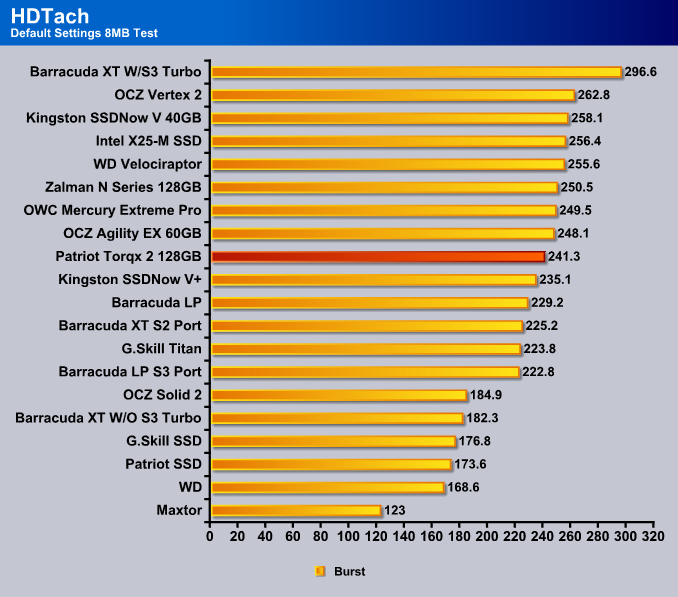
The results for burst speed in Patriot Torqx 2 have been somewhat skewed and show up as a mere 99.2 MB/s, which does not make sense considering that the average speed lands somewhere around 229 MB/s. However, it is common for benchmarks like HD Tune Pro to be unable to assess the burst speed of the SSDs since these test suites were originally designed to test hard disk drives, which have a significantly lower access time.
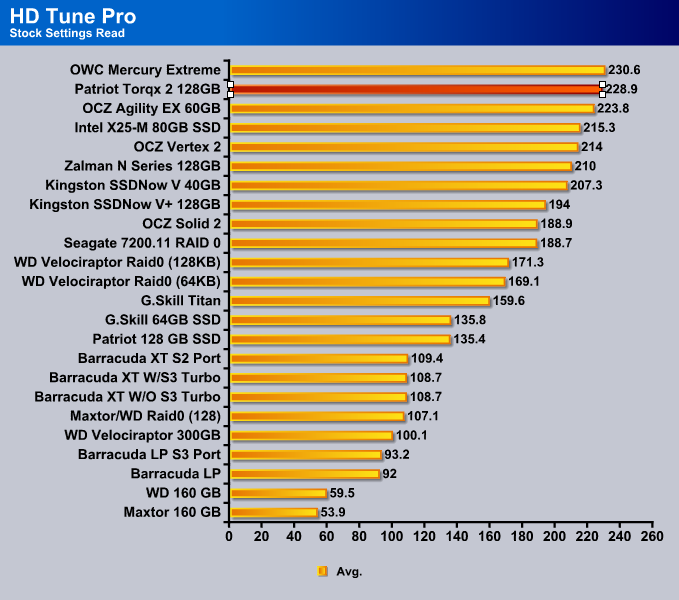
Finally, the average performance of 228.3 MB/s speaks for itself. Clearly the Patriot TorqX 2 is able to achieve an outstanding read performance by minimizing the deviation of the minimum and maximum reads, which what the SSDs are supposed to do.
HDTach
Just like HD Tune Pro, HD Tach is a bench suit with similar tested parameters. The basis of the test lies in the drive’s sequential read speed. Sequential read parameter is the closest approximation to the top maximum performance of the drive. In addition, this test also provides us with the burst speed parameter which was not accurately assessed in other benches. Finally the plot spans through a full maximum capacity of the drive and demonstrates whether the drive is capable of performing at its peak regardless of the amount of data already present on the drive.
Quick Bench (8mb zones)
After testing the Patriot TorqX 2 by sequential read with 8mb zones, we were pleased to discover a stable performance through the test. The average read of this SSD yet again landed on the mark of 228.9 MB/s providing results congruent with previous tests. Access time yet again was estimated to be at about 0.1ms, which is fairly close to the value that we have seen in other benches. However, the major difference came in the solid burst speed, which have not yet seen. This could be explained due to the fact that other benchmarks were not specifically designed for an SSD, so the burst speed results are generally a hit and miss. In this instance we see an impressive burst speed of 241.3 MB/s which goes well with an average speed of 228.9 MB/s.

In comparison to the other drives Patriot TorqX 2 does not particularly shine with the high burst speed. With burst speed of 241 MB/s this drive is designed to deliver a more stable overall performance rather than gain its performance through by bursting and later catching up.
In terms of average performance in sequential read Patriot TorqX 2 really seems to stand out of the crowd delivering an average read of 228.9 MB/s. Its performance places this SSD right next to other high-end SSDs like the Zalman N Series 128 GB solid state drive.
Conclusion

As we have mentioned, this is the first time that we got to test a new Phison controller, which is completely different from the commonly tested Sandforce controllers in drives from vendors like Zalman. Therefore, in terms of innovation Patriot did not fail to bring something new to the table. The quality of the rest of the components was nothing short of top notch, and while the components are more native to Taiwan, a lot of consumers could definitely appreciate the quality of the drive. In addition, considering the stable performance and architecture, we are to assume that even smaller variants of Patriot TorqX 2 will be able to perform at their peak regardles of how much the space is used. Finally, while the choice of features available for SSDs is rather limited, the TRIM function, with the simple ability to clear the drive of unwanted files is extremely useful and easy to use.
| OUR VERDICT: Patriot Torqx 2 128GB SSD | ||||||||||||||||||
|
||||||||||||||||||
| Summary: The Patriot TorqX 2 128GB SSD is a great high performance SSD for those who want sturdy and powerful drives without going all out. It has great performance in all categories, useful features like the TRIM command, and high quality components. For its peformance and quality, it earns the Bjorn3D Silver Bear Award. |
 Bjorn3D.com Bjorn3d.com – Satisfying Your Daily Tech Cravings Since 1996
Bjorn3D.com Bjorn3d.com – Satisfying Your Daily Tech Cravings Since 1996














